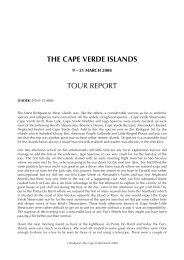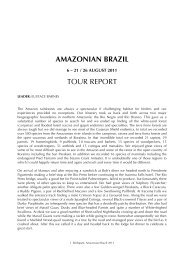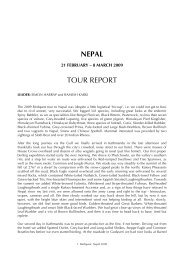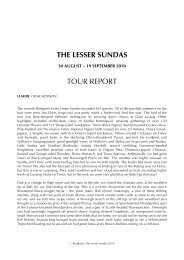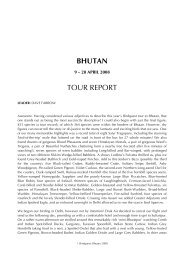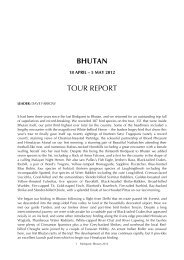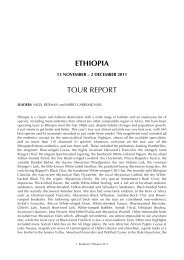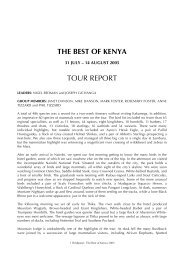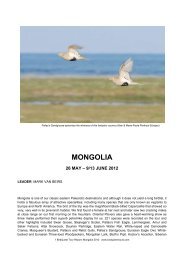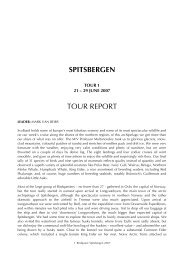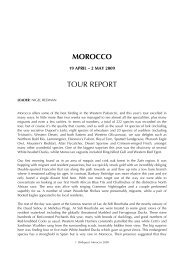Download Full Tour Report 1202kb - Birdquest
Download Full Tour Report 1202kb - Birdquest
Download Full Tour Report 1202kb - Birdquest
You also want an ePaper? Increase the reach of your titles
YUMPU automatically turns print PDFs into web optimized ePapers that Google loves.
OPISTHOCOMIDAE<br />
Hoatzin Opisthocomus hoazin: A social nesting bird, we observed groups of breeding birds at<br />
Amazonía Lodge and later we found them to be common at Cocha Camungo and Cocha<br />
Blanco. One of the very few birds that almost entirely subsist on a diet of leaves, this odd<br />
species has some peculiar attributes, including microbial foregut fermentation to convert<br />
plant cellulose in consumed foliage into simple sugars, and a highly modified skeleton to<br />
accommodate its large crop. Once thought to be the lost link to the feathered dinosaur<br />
Archaeopteryx because of the chick’s clawed wings, these claws are now considered a<br />
recent secondary adaptation to the chicks having to clamber up vegetation if they are<br />
forced to evacuate the nest due to a threat. The placement of this order is still<br />
controversial, with the most comprehensive genetic data set to date unable to resolve its<br />
relationships, there being no evidence for a close relationship to any order within the<br />
Neoaves.<br />
CUCULIDAE<br />
Little Cuckoo Coccycua minuta: Most of us saw the bird at Amazonía Lodge that perched briefly out<br />
of the thick cocha vegetation.<br />
Ash-coloured Cuckoo Coccycua cinerea: This austral migrant was very much a surprise sighting on<br />
the outskirts of Puerto Maldonado. It appears to have been present here for at least a<br />
week as a group of visiting birders saw it a few days later at the same spot.<br />
Squirrel Cuckoo Piaya cayana: Common from the lowlands into the Cosñipata valley near Cock-ofthe-Rock<br />
Lodge.<br />
Dark-billed Cuckoo Coccyzus melacoryphus: One at Amazonía Lodge was seen along the jeep<br />
track.<br />
Smooth-billed Ani Crotophaga ani: This species was most abundant in the deforested plains above<br />
Pilcopata and around Puerto Maldonado.<br />
Striped Cuckoo Tapera naevia: A very obliging individual was admired at close-range through the<br />
scope near Puerto Maldonado. The last new lowland bird of the trip!<br />
STRIGIDAE<br />
Rufescent Screech-Owl Megascops ingens (H): Strangely, this one refused to respond after initially<br />
responding during my pre-dawn scouting.<br />
Tawny-bellied Screech-Owl Megascops watsonii: At Amazonía we were surprised when, upon<br />
switching on the torch, an individual was perched much closer than we had thought.<br />
Moments later we saw the same bird again perched in the lower branch of a mango tree.<br />
Crested Owl Lophostrix cristata: We saw a perched bird high in the canopy at Manu Wildlife Centre.<br />
Band-bellied Owl Pulsatrix melanota (H): One bird was heard near Cock-of-the-Rock Lodge.<br />
Mottled Owl Ciccaba virgata (H): One heard-only record pre-dawn from Amazonía Lodge.<br />
Black-banded Owl Ciccaba huhula (H): We attempted to see a calling bird at Amazonía Lodge but it<br />
remained distant.<br />
Rufous-banded Owl Ciccaba albitarsis (H): A very distant heard-only from the Wayquecha station.<br />
Yungas Pygmy-Owl Glaucidium bolivianum: We had superb views of a close-perched bird on our<br />
first day in the Manu cloudforest.<br />
Amazonían Pygmy-Owl (Hardy’s P-O) Glaucidium hardyi: Several were recorded in the Manu<br />
lowlands of which some of us saw two of the birds in flight but it was not for lack of<br />
trying as our sore necks were testament. Named after J.W. Hardy, who’s published a<br />
series of audio tapes on Neotropical bird families.<br />
Ferruginous Pygmy-Owl Glaucidium brasilianum: A singing bird at Pantiacolla was seen well in<br />
second-growth forest.<br />
Burrowing Owl Athene cunicularia: Three different birds were seen along the Rio Madre de Dios and<br />
as many as five birds were seen at Lomas de Lachay.<br />
18 <strong>Birdquest</strong>: The Manu 20011




